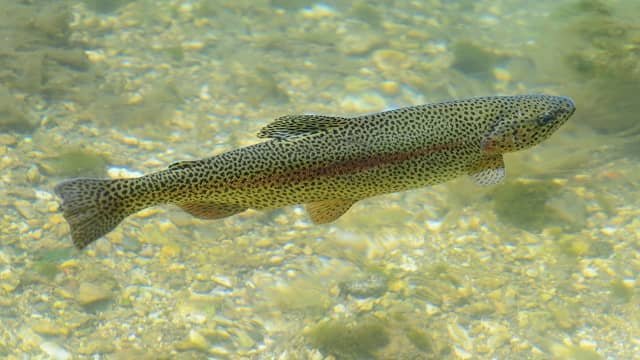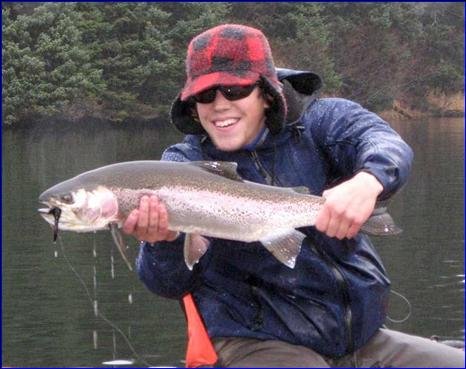
by UNM
Researchers in the Salinas Lab in The University of New Mexico’s Department of Biology have discovered an immune structure in the nasal cavities of rainbow trout that scientists previously didn’t know existed. The new knowledge will allow fish immunologists better understand the efficacy of aquaculture vaccines.
While fish and mammals have similar immune systems, there are important anatomical differences. And, for the most part, the immune system of non-mammalian vertebrates is not well known.
The investigators noted that this nasal immune structure has molecular features of “germinal centers,” a reaction that happens in humans when we get vaccinated or infected. Germinal center reactions are often used as markers for vaccine responses.
“We knew about germinal center reactions in lymphoid structures in humans, mice and birds, but we didn’t think the architecture of the fish immune system had such structures,” said Irene Salinas, a professor and associate chair in biology.
“Many people have looked for them including us, but we couldn’t find them, mainly due to the lack of the right tools,” she said.
The research was published in a paper in the December edition of the Journal of Immunology. UNM Biology Ph.D. student Ben Garcia was the lead author. Fen Dong, Elisa Casadei, Pedro A. Castrillo, Julien Resseguier and collaborators at the University of Idaho also form part of this team and are co-authors in the paper.
“We have been investigating the nasal immune system of fish for a decade, but we kept missing these unique structures full of lymphocytes,” Salinas said.
Until 2018, we kept dissecting the olfactory organ of trout out of the fish nasal cavities leaving behind the answer they were looking for. Castrillo, who is a veterinarian and was visiting the Salinas lab for a few months, suggested keeping the discarded part and examining the entire undisturbed nasal cavity.”
Stay Always Informed
Join our communities to instantly receive the most important news, reports, and analysis from the aquaculture industry.
“We were basically leaving that tissue behind, and that’s where this structure is,” she said.
The work, funded by a three-year, $500,000 grant from the USDA’s National Institute of Food and Agriculture, is a groundbreaking study in the evolution of immunity that has implications for fish health, vaccinology and the U.S. fish farming industry, Salinas said.
The B cells in the germinal centers are part of the immune system and create antibodies to fight viruses and bacteria, giving researchers a look at how fish react to vaccines. There is yet a lot of work to be done because the ultimate proof that these structures function like mammalian germinal centers needs to be produced. This involves a series of ongoing experiments that would demonstrate that the B cells within the trout nasal germinal center-like structures are maturing in response to infection or vaccination. This is done by investigating the sequences of the B cell receptors, known as the repertoire. Demonstrating clonal expansion of specific B cells in response to a vaccine is a critical part of the puzzle that is yet to be completed.
“When we were developing vaccines until now, we didn’t know where to look to measure the impact of the vaccine on fish immune systems,” she said.
With this new information, vaccinations in fish can be better understood, including the best interval time between doses of vaccinations that require more than one administration. There is also hope that the research can reduce the cost of vaccinating fish. The team hopes the USDA will continue to support their work to optimize booster vaccines for aquaculture that can be delivered without injection (mucosal vaccines).
Next up for the lab is also to work on similar research using zebrafish, which Salinas has studied for years.
Salinas said she’s glad to be proven wrong after a decade of thinking fish didn’t have germinal structures because that’s sometimes how science works.
“It’s part of the journey,” she said.
Reference (open access)
Benjamin Garcia, Fen Dong, Elisa Casadei, Julien Rességuier, Jie Ma, Kenneth D. Cain, Pedro A. Castrillo, Zhen Xu, Irene Salinas; A Novel Organized Nasopharynx-Associated Lymphoid Tissue in Teleosts That Expresses Molecular Markers Characteristic of Mammalian Germinal Centers. J Immunol 1 December 2022; 209 (11): 2215–2226. https://doi.org/10.4049/jimmunol.2200396
Editor at the digital magazine AquaHoy. He holds a degree in Aquaculture Biology from the National University of Santa (UNS) and a Master’s degree in Science and Innovation Management from the Polytechnic University of Valencia, with postgraduate diplomas in Business Innovation and Innovation Management. He possesses extensive experience in the aquaculture and fisheries sector, having led the Fisheries Innovation Unit of the National Program for Innovation in Fisheries and Aquaculture (PNIPA). He has served as a senior consultant in technology watch, an innovation project formulator and advisor, and a lecturer at UNS. He is a member of the Peruvian College of Biologists and was recognized by the World Aquaculture Society (WAS) in 2016 for his contribution to aquaculture.



